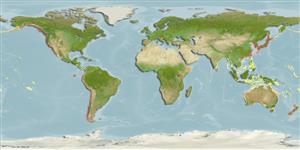Common names from other countries
Environment: milieu / climate zone / depth range / distribution range
Ecologia
; intervalo de profundidade 0 - 5 m (Ref. 1815). Temperate
Indo-Pacific and the Mediterranean: Korean Peninsula.
Length at first maturity / Tamanho / Peso / Idade
Maturity: Lm ? range ? - ? cm Max length : 4.0 cm TRKL macho/indeterminado; (Ref. 1815)
Comparatively large animals of grayish yellow color. Body cylindrical. Trunk region 0.4 - 4 cm
long. Introvert almost as long as trunk region. Entire body surface densely set with large (0.06 - 0.08 cm) dome-shaped black papillae. Papillae especially numerous on terminal and anal shields. Cephalon bear-ing crown of 21-29 tentacles in horseshoe-like arrangement
around heart-shaped nuchal organ. Behind cephalon, introvert bearing specialized cuticular appendages (scalids), arranged into 15-30 circles. Two ventral and two dorsal retractors of introvert. Ventral retractors anchored in posterior third of trunk. Contractile vessel simple, with no lateral branches. Intestine with 10-18 loops, in dependence on animal size. Longitudinal
musculature of body wall divided into pronounced, isolated longitudinal bands. Spindle-shaped muscle fastened at terminal end of trunk; 1-3 fixing muscles. Anus located somewhat in front of or level with nephrophores. Wing muscles well-developed. Rectal diverticulum
absent. 2 nephridia fastened to body wall along 1/3 of their length via thin mesenterial filaments. Nephridiums 30 - 50 percentage as long as trunk (Ref. 1815).
Intertidal and subtidal on vegetation (Ref. 1815). Depth based on occurrence (Ref. 1815); to be replaced with better reference. Subtidal (Ref. 1815).
Morozov, T.B. and A.V. Adrianov. 2002. (Ref. 1815)
Status na Lista Vermelha da IUCN (Ref. 130435)
Status no CITES (Ref. 108899)
Not Evaluated
Not Evaluated
Uso pelos humanos
| FishSource |
Ferramentas
Mais informação
Idade/TamanhoCrescimentoComprimento-pesoComprimento-comprimentoMorfologiaLarvasAbundância
Fontes da internet
Estimates based on models
Preferred temperature
(Ref.
115969): 7.7 - 28.8, mean 21.6 (based on 2164 cells).
Vulnerabilidade
Low vulnerability (10 of 100).
Categoria de preço
Unknown.
